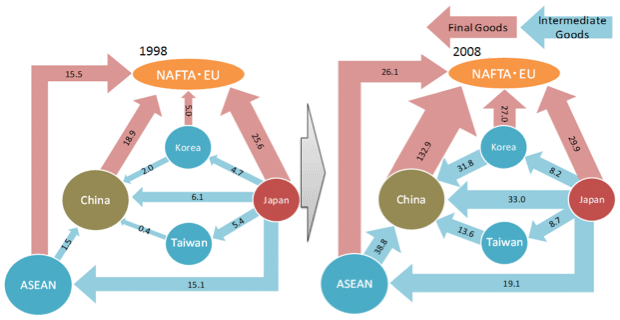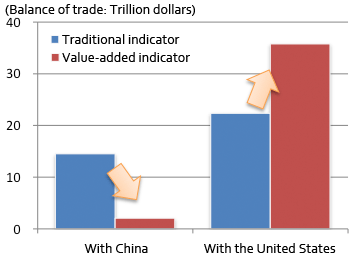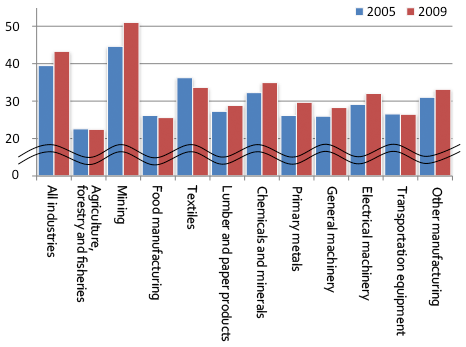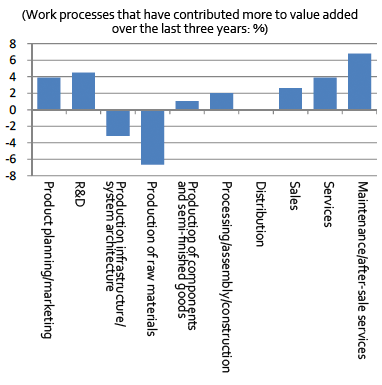What is "Trade in Value Added?"
On January 16, 2013, the Organisation for Economic Co-operation and Development (OECD) published new trade statistics based on value added (Note 1) (Trade in Value Added, hereinafter TiVA). TiVA are statistics that rearrange trade structures among countries and regions from a value-added standpoint. It will be possible to get a glimpse into the transformation of the industrial structure in Japan from the TiVA.
Before looking at trade statistics based on value added, let's look at changes in the trade structure in Japan, using the electrical machinery industry as an example. Figure 1 shows changes in the trade structure of the electrical machinery industry in East Asia from 1998 to 2008. The arrows show the flow of trade, with the pink arrows indicating final goods and the blue ones representing intermediate goods. In 1998, the export of final goods from Japan to North America and Europe was the largest. Looking at the situation in 2008, however, the export of final goods from Japan to North America and Europe generally stayed constant, while that of intermediate goods from Japan to East Asian economies such as China, Korea, and Taiwan increased significantly. Viewing these flows from Japan's perspective, they indicate that its main trading partners have changed from North America and Europe to East Asia.
(1998 - 2008)

Figure 2 shows Japan's balance of trade with the United States and China. The blue bars indicate the net balance of trade, which subtracts imports from exports. When "balance of trade" is discussed, it is usually in reference to this net balance of trade. In 2009, Japan's trade surplus with China was on a level equivalent to that of the United States, indicating that China was a major trading partner for Japan.
However, looking at the balance of trade from a value-added standpoint, the picture changes. For example, if intermediate goods produced in Japan are exported to China and the subsequent final goods assembled in China are exported to the United States, the traditional indicator shows that Japan's trade surplus with China expands, while China's trade balance with the United States also expands. However, looking at this trade from a value-added perspective, since some of the value added included in the final goods exported from China to the United States is created in Japan, the final user country of the intermediate goods exported from Japan to China turns out to be the United States.
The TiVA published by the OECD redefines the trade structure from this perspective. In the TiVA, the countries that are the final users of the goods and services produced in Japan can be seen. The red bars in Figure 2 show the balance of trade based on value added. Looking at Japan's balance of trade with the United States and China based on value added, its balance of trade with China has become almost zero, while that with the United States has expanded. This implies that the final users of the goods and services produced in Japan are developed countries.

Transformation of the industrial structure in Japan
While the difference between the traditional balance of trade and that with value added suggests that trade and industrial structures in East Asia are becoming more complex, it can also be confirmed through the TiVA that the industrial structure in Japan has also been transformed. Figure 3 shows the percentages of value added in the export goods created in each industry in Japan that can be attributed to the service industry in 2005 and 2009. For example, in the case of the electrical machinery industry, approximately 30% of the value added included in export goods is from the service industry.
Comparing these percentages in 2005 and 2009 shows that the service industry's contribution to exports has increased mainly in the processing and assembly-type manufacturing industries. This means that the service industry's contribution to exports has been increasing, and suggests that Japan's domestic industrial structure has been changing.

The results of a questionnaire sent to listed companies (Figure 4) confirm that the contribution to value added of non-manufacturing processes such as marketing and product development, research and development (R&D), and maintenance and after-sales service has been increasing over the last three years, and it appears that the boundary between the manufacturing industry and the service industry is disappearing.

Summary and Future Challenges
We have reviewed changes in Japan's trade and industrial structures based on the TiVA, the trade statistics based on value added published by the OECD. Based on the TiVA, the following points have become apparent:
- Regarding exports from Japan, those of intermediate goods and capital goods to Asia have been increasing, but the final users of the goods and services produced in Japan are still mainly developed countries.
- Regarding value added in export goods, the proportion attributable to the service industry has been increasing. This shows that the service industry is playing an increasing role in the manufacturing industry, and suggests that the transformation of this business category is progressing even within the industries (Note 2).
Based on these findings, the issues described below remain challenges from an analytical and policy standpoint.
One issue from an analytical point of view is that the TiVA only sheds light on the structure for creating value added as a process. For example, in the case where capital goods are exported from Japan to Asian countries and are used to manufacture products, a part of the created value in Asia is attributed to Japan. With the TiVA, however, the value added created by capital goods is counted as that in the country that uses the goods. Also, the overseas local subsidiaries of Japanese companies use the know-how and skills of their parent companies, and some of the value added created by them flows back to Japan in the form of dividends and royalties. However, the TiVA cannot encompass the structure to create this value added. In the future, it will be necessary to figure out a more comprehensive structure for creating value added, taking into account the role of capital goods and the flow of income.
As a policy issue, an increase in risk due to the complexity of trade and industrial structures can be pointed out. The Great East Japan Earthquake and the floods in Thailand, etc. have brought to light the risks and uncertainties associated with the complexity of long-distance supply chains. In the future, it will be necessary to study ways of dealing with such risks. In addition, because Blonigen (2013) (Note 3) has confirmed that industrial policies for upstream industries also have an impact on downstream industries, the competitiveness of the service industry could have an impact on other industries, if we consider them in the same context. In this regard, it is conceivable to see that strengthening the competitiveness of the service industry is becoming an increasingly important policy issue.


